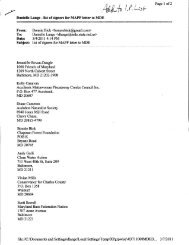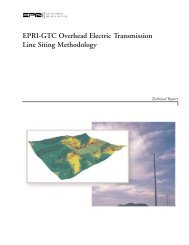Mid-Atlantic Power Pathway Chalk Point Substation to Indian River ...
Mid-Atlantic Power Pathway Chalk Point Substation to Indian River ...
Mid-Atlantic Power Pathway Chalk Point Substation to Indian River ...
Create successful ePaper yourself
Turn your PDF publications into a flip-book with our unique Google optimized e-Paper software.
<strong>Mid</strong>-<strong>Atlantic</strong> <strong>Power</strong> <strong>Pathway</strong> Environmental Review Document<br />
<strong>Chalk</strong> <strong>Point</strong> <strong>Substation</strong> <strong>to</strong> <strong>Indian</strong> <strong>River</strong> <strong>Substation</strong> Volume II – Environmental Analysis of<br />
April 13, 2011 <strong>Chalk</strong> <strong>Point</strong> <strong>Substation</strong> <strong>to</strong> MD/DE State Line<br />
Table 1.2-1 (continued)<br />
Soil Series Within the Project Right-of-Way and Project Boundaries<br />
Soil Series Description<br />
Ochlockonee The Ochlocknee series consists of very deep well drained soils on flood plains.<br />
Typically, the surface layer is brown sandy loam about 6 inches thick. The substratum is<br />
a brown fine sandy loam layer about 31 inches thick. This in turn is over a dark brown<br />
very fine sandy loam layer about 7 inches thick which is over dark yellowish brown<br />
loamy fine sand about 18 inches thick. Depth <strong>to</strong> a root restrictive layer is greater than 60<br />
inches. Water movement in the most restrictive layer is moderately high. Available<br />
water <strong>to</strong> a depth of 60 inches is moderate. Shrink-swell potential is low. This soil is<br />
rarely flooded. It is not ponded. A seasonal zone of water saturation is at 48 inches<br />
during January, February, March, April, and December. This soil does not meet hydric<br />
criteria.<br />
Othello The Othello series consists of very deep poorly drained soils on uplands. They formed in<br />
silty material underlain by coarser sediment. Typically, these soils have a dark grayishbrown<br />
silt loam surface, 9 inches thick. The subsoil between 9 and 18 inches is light<br />
olive gray silty clay loam with prominent yellowish-brown mottles and between 18 and<br />
29 inches is light gray, silty clay loam with prominent yellowish-brown mottles. A<br />
mottled gray sandy loam substrata grades in<strong>to</strong> a light gray loamy sand below 29 inches.<br />
Depth <strong>to</strong> a root restrictive layer is greater than 60 inches. Water movement in the most<br />
restrictive layer is moderately high. Available water <strong>to</strong> a depth of 60 inches is moderate.<br />
Shrink-swell potential is low. This soil is not flooded. It is not ponded. A seasonal zone<br />
of water saturation is at 6 inches during January, February, March, April, and May.<br />
Organic matter content in the surface horizon is about 2 percent. This soil meets hydric<br />
criteria.<br />
Piccowaxen The Piccowaxen component is found on terraces, fluviomarine terraces. The parent<br />
material consists of silty and loamy fluviomarine deposits. Depth <strong>to</strong> a root restrictive<br />
layer is greater than 60 inches. The natural drainage class is somewhat poorly drained.<br />
Water movement in the most restrictive layer is moderately low. Available water <strong>to</strong> a<br />
depth of 60 inches is high. Shrink-swell potential is low. This soil is not flooded. It is<br />
rarely ponded. A seasonal zone of water saturation is at 12 inches during February.<br />
Organic matter content in the surface horizon is about 4 percent. This soil does not meet<br />
hydric criteria.<br />
Pone The Pone series consists of very deep, very poorly drained soils formed in organic<br />
deposits overlying alluvial or marine sediments of the <strong>Atlantic</strong> Coastal Plain. They are<br />
found on low-lying uplands and closed depressions. Typically the surface layer is black<br />
mucky loam 14 inches thick. The subsoil from 14 <strong>to</strong> 37 is grayish brown sandy loam<br />
and light gray loamy sand. The substratum from 37 <strong>to</strong> 47 is gray sand. From 47 <strong>to</strong> 69<br />
inches it is gray silt loam. Depth <strong>to</strong> a root restrictive layer is greater than 60 inches. The<br />
natural drainage class is very poorly drained. Water movement in the most restrictive<br />
layer is high. Available water <strong>to</strong> a depth of 60 inches is moderate. Shrink-swell potential<br />
is low. This soil is not flooded. It is not ponded. A seasonal zone of water saturation is at<br />
0 inches during January, February, March, April, May, June, and December. Organic<br />
matter content in the surface horizon is about 9 percent. This soil meets hydric criteria.<br />
1-24




